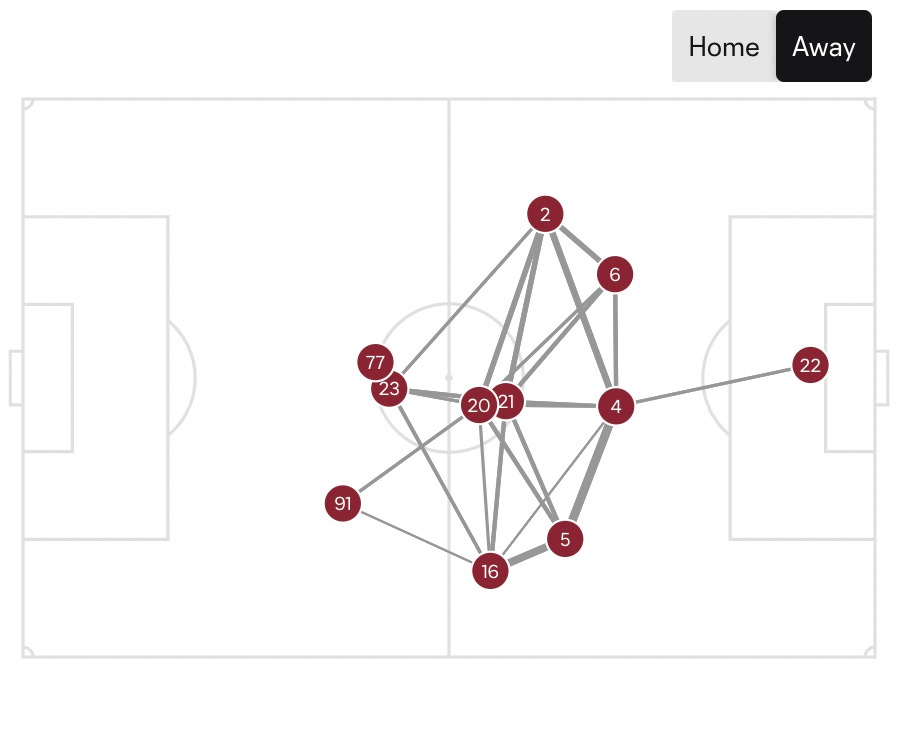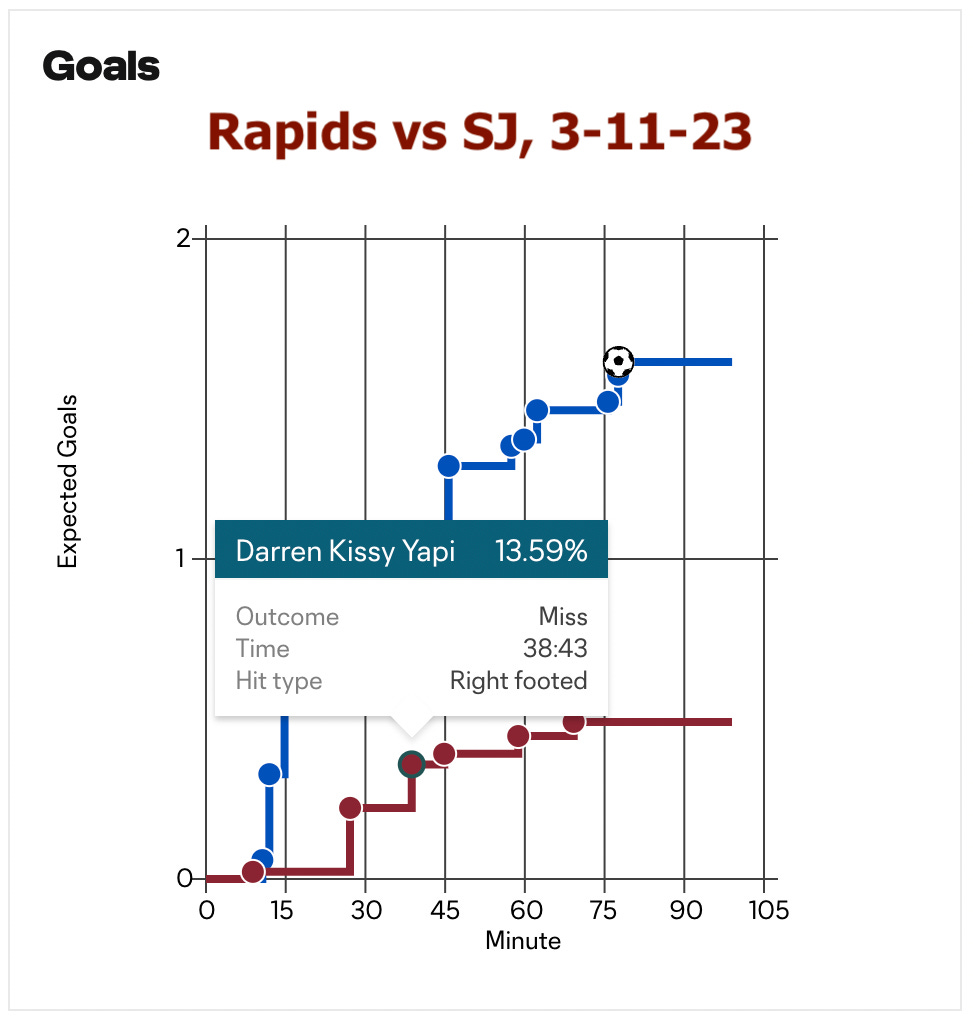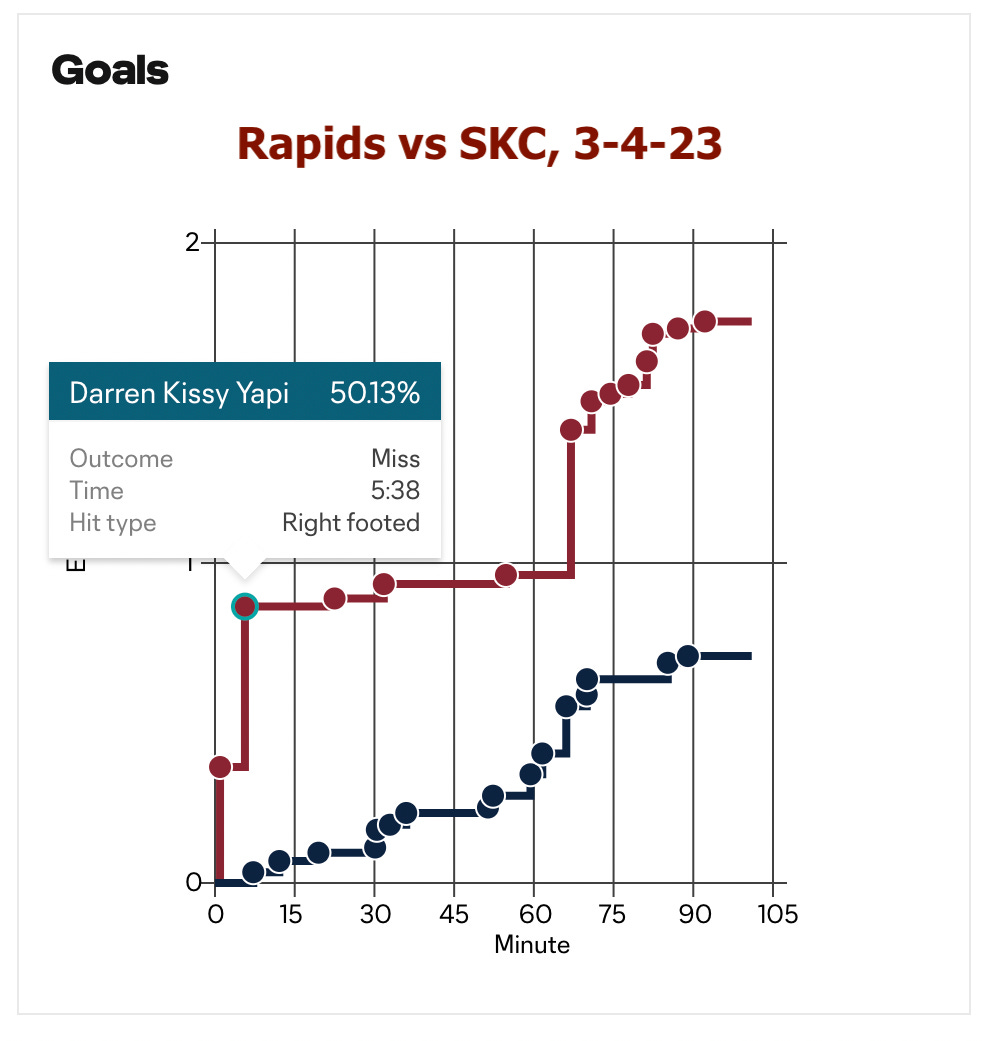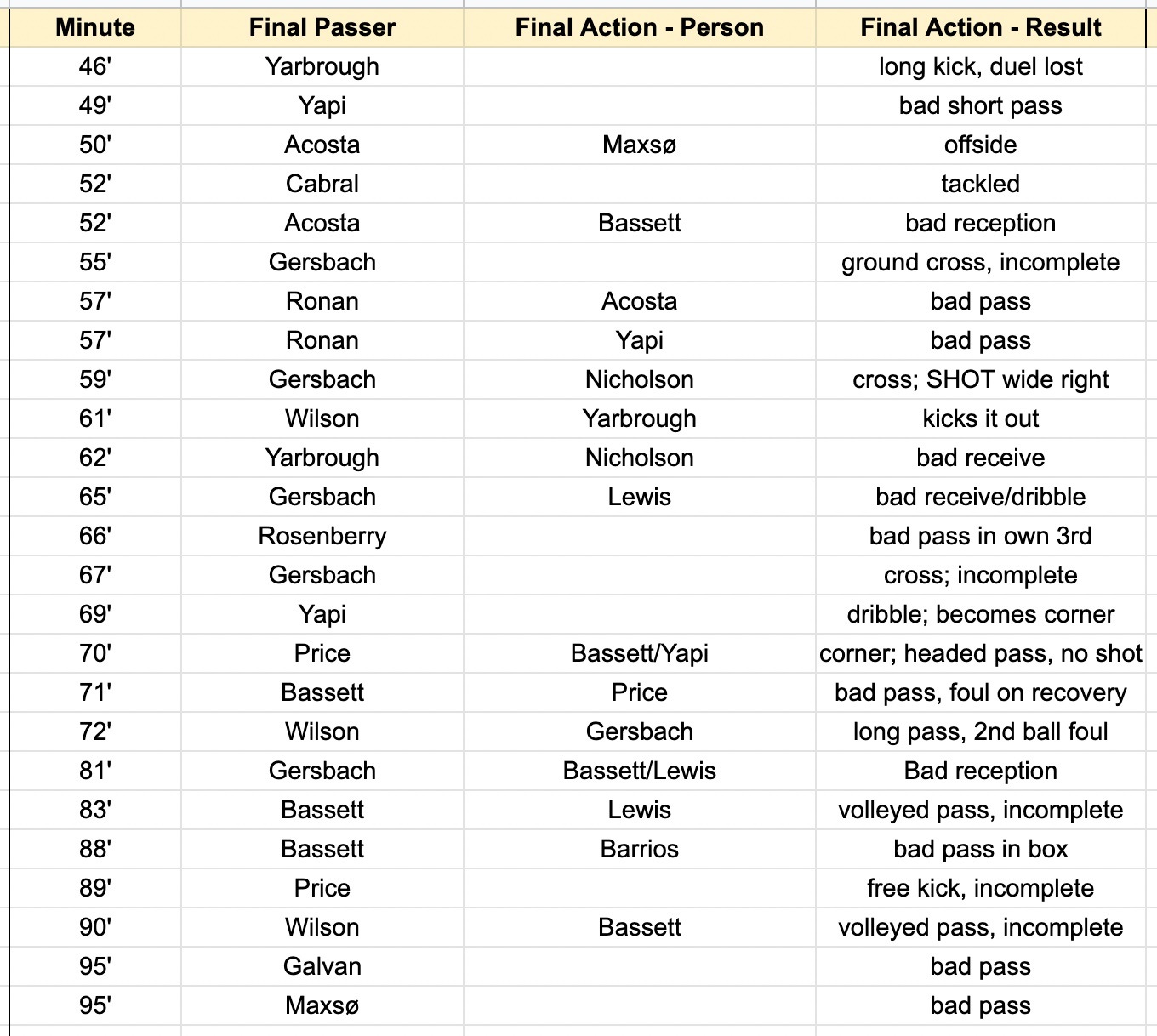Backpass: It'd be cool if the Rapids scored
Three games in, no goals. My sources tell me scoring is often an important part to winning soccer games. Also: a comment on recent local media unpleasantness.
There was no Backpass in Week 2 of the MLS season because, well, writing about a second straight goalless game for the Burgundy Boys seemed like a chore. Also, there wasn’t that much new to say about an offense that did not create much. Yarbrough (AKA Yarbs, AKA Yeah Barbara) had a good game! But a goalless draw is not a lot of fun to rewatch, or write about, and therefore dear readers I spared you the suffering of reading about it. You’re welcome.
Sigh. That makes recapping our game in Week 3 – a fairly miserable affair, offensively-speaking for the Rapids – even more painful. But because I am still in the energetic and engaged phase of the season, I decided to do a meticulous and methodical analysis of why the Rapids offense is comatose. So buckle up for hardcore tactics nerding!
Formation Change
Colorado switched things up from the previous weeks, where they came out in a 4-3-3, and deployed a 3-5-2 against San Jose; when defending deep, this looked like a 5-4-1. That allowed them to get Danny Wilson into the backline to do the distribution, which gave Andres Maxsø and Lalas Abubakar a chance to breathe and simply defend. I liked that. I liked it even more when Abubakar had to come off and Keegan Rosenberry slid over into CB, with Sam Nicholson playing as an inverted RWB on the right side.1 Sam immediately had an impact. His first touch was on this heads up play below, which had the highest xG of any Rapids play on the night:
In attack, it looked more like a 3-4-3, as Cole Bassett came high in the attack to support Kévin Cabral and Darren Yapi, with Connor Ronan and Bryan Acosta sitting deeper to protect, and the ball-side wingback up in attack as well. This was annoyingly cautious – primarily there were only four attackers for much of the game – but probably prudent, at least for the first 45 minutes. Win at home, draw on the road they say. Here’s how the average position and passing map looked in this game:
The passing connections show that the team favored ‘William Yarborough to Danny Wilson, Danny Wilson to Alex Gersbach’ more than any other connections. And although this produced a fairly safe match (76 percent overall passing) that allowed the team to hold back players for defense, it also made for an attack that was incredibly dull. It produced just 0.45 xG total for the Rapids on the night. That xG number was equally in Week 2 against SKC on just one shot alone.2
Only two Rapids shots in Week 3 were between 0.1 and 0.2 xG: a free kick in the 28th minute by Bryan Acosta that Maxsø headed high, and a Darren Yapi shot in the 39th minute created by that nice little dribble and dish by Sam Nicholson right after he checked into the match for the injured Abubakar (the gif posted above). So what happened?
The Scoring Drought Explained (at least, the part in San Jose)
Occam’s razor - the simplest possible explanation based on the facts available - would conclude that the team is missing Diego Rubio, and therefore they can’t score goals. That is probably at least partially true.
However, when a team only generates 0.45 xG, it could be that the final third attackers are lacking in creativity, which Rubio’s return would help. Or it could be that the team isn’t penetrating effectively enough to give those front line lads a real look at the goalmouth. So I looked at all the Rapids possessions against SJ; 46 in total; to determine if there was something lacking. Here are all those possessions:
Gersbach is involved in the final pass or action of 11 possessions out of 46, or 24 percent. Rosenberry and Nicholson combined are involved in only 8 possessions. 3
Among midfielders, Ronan is involved in 4 final passes or actions; Bassett is involved in 11; Acosta is involved in 8 - but 2 are corner kicks. Cabral had 2 possessions where he turned it over, and 2 where his passer didn’t find him with the ball properly; he was effectively marked out of this game completely. Yapi is similar: the team couldn’t reach him on 2 passes, and he made a bad pass to kill a possession. He had one good shot, and one dribble that was knocked out of a corner.
My observations are this:
The team relies on Alex Gersbach like he was 2020 Sam Vines or 2018 Edgar Castillo. Both were the pivot of the Rapids attack at left back, who would either bend in perfect crosses or put dudes to the sword as they dribbled at them like a maniac. Gersbach has so far not proven to be Sam Vines or Edgar Castillo, and this is a problem.
The formation and tactics dictated that Connor Ronan and Bryan Acosta stay back, and thus they only got involved in final actions a total of 10 times. If you have more final third targets, it forces your opponent to key on more players. Less variety of attackers in the final third, and you force that smaller number of attackers to be more effective.
Those final third targets for Colorado were Bassett, Yapi, and Cabral. Bassett was responsible for the final action 7 times; he had one shot. That shot was a terribly mis-hit header. Yapi had one good shot, at 39’, and missed. Other than that, he wasn’t great. Cabral had the final action 5 times; one was a blocked shot. He was never the final passer in 46 possessions, which might indicate that he’s … not interested in passing, and thus he’s hell bent on either dribbling into the box or making that final run. Which is ok if he’s going to successfully finish - but it’s less great if he’s not going to finish and not going to be active in the buildup. The ‘unselfishly does great stuff in buildup’ stat to use is Goals Added, or G+. Cabral’s total 2022 G+ was -0.82; among the bottom quarter of MLS wingers. In other words, he doesn’t have a great track record as a productive cog in the buildup. In total, the final product from the front three was bad. Fotmob’s auto-rating system had Bassett, Yapi, and Cabral at 6.2, 6.1, and 6.1 out of 10, respectively. That’s pretty low.
While adding Wilson to the back line did to steady the defense, it also subtracted from the offense in terms of having enough men to probe behind enemy lines. Tactically the idea was sound, but the result was a pretty anemic xG. I’d be ok if we kept trying it in some games down the line, but maybe this isn’t gonna work long term.
If you go back and watch this game again (something I do not recommend), you’ll see that the Rapids did not break out in transition in this match at all. Not once. Their press wasn’t effective in the opponents third or in the middle third, and they never, ever, not once, turned the ball over and raced to the other end. It was probably an outgrowth of their cautious and deep positioning, but also was the result of eleven guys just not looking up and thinking about striking on the break. The Rapids are the ‘anti-showtime’ team in MLS. And that is probably why this game was so mind-numbingly dull from a Rapids attacking standpoint.
This is the third game of the year. There’s a lot left of the season. This team will probably play better, and specific individuals will have better games going forward. Connor Ronan was once again a bring spot with this team. Jack Price returned as a sub and looked feisty in the tackle and precise on dead balls. The centerbacks were all very good. Yarbs had that killer save. There’s what to build on from this game.
If they can just breathe some life into this attack – and maybe be a little bolder - it feels like there’s a win in store for this team. If. Maybe.
Media Unpleasantness
This past week, fellow citizen soccer journalist Joseph Samelson covered a Rapids 2 match, and tweeted a few overheard comments from coaches and players. A member of the Rapids front office team contacted him, apparently, to upbraid him for putting these two foul-mouthed interludes onto twitter.

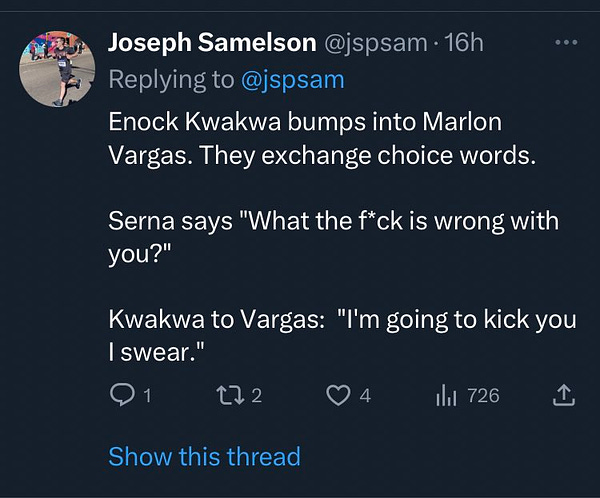
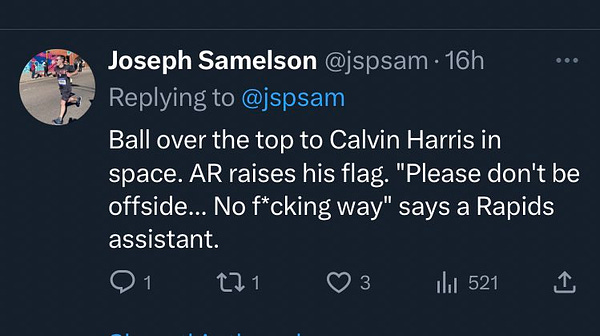
This is not the first time the Rapids have overreached in trying to restrict what the media can or cannot say, or can and cannot attend, where media can and cannot go. In 2014, MLSsoccer.com writer Chris Bianchi was fired for opining that the Rapids front office deserved the blame for the team’s poor performance.4 The Rapids had a season where I was told I could not attend training if another Burgundy Wave reporter was also there; because, reasons? Sometimes information from the team has been hard to come by. Sometimes interviews have been hard to come by.
The Rapids are also unique in the Denver sports landscape in that they do not have an open locker room for post-game reporting. The team chooses which players will speak post game. Alright, fine. We Rapids reporters have simply made do.5
The communications team for a sports franchise has a very strange, bifurcated job: 1) promote the team by giving reporters access so they can provide the team with free advertising for their product, and 2) protect the team by restricting access to the things the team does not want to bring to light. When the Rapids were good in 2016, there were ample opportunities to hear Tim Howard talk about how great everything was. When the team was struggling with grouchy players – Shkëlzen Gashi in 2017-18, Stefan Aigner in 2018 – it was very difficult to speak with them. And - I get it. That’s the job these guys have to do - try to control the narrative.
But what happened with the wagging of the finger at Joe Samelson was a mistake. Joe Samelson and Matt Pollard are really the only media willing to even cover Rapids 2. 6 As a reserve team at the third tier of the US soccer pyramid, it has very little following outside of a few sickos. But because it is meant to be a proving ground for young players, Rapids 2 should be a marketing bonanza for the Rapids. The overhead and salary costs are practically nothing, and as long as that space helps to produce an MLS-caliber player every two to four years, it’s a huge success. For good reporters, this is where you want to be for those touchy-feely ‘local boy makes good’ stories (Dillon Serna, Cole Bassett, Sam Vines, Darren Yapi, Yaya Toure). And those stories will help drive sales to pay for the senior team Colorado Rapids games at DSGP. You want media there.
And that means - you have to let them report on what they see and hear, even if that includes some blue language. Teams have to accept that sometimes reporters write the truth, even when the truth isn’t pretty.
Your million-dollar signings sometimes turn out to be turds. You lose games because players do stupid things. Managers say the darndest things.
We report it. We report the good. We report the bad. We tell the truth, as we see it and hear it.
A challenging thing in the modern era is that sports teams also now have the ability to produce their own content - meaning, more than in the pre-internet era, they might conclude that they don’t need independent media at all. The Rapids Comms team might like to horde all the really great exclusive interviews and documentaries for themselves. And I get that.
But team produced content isn’t at all objective. It’s positive-PR spin for the team. The Rapids aren’t going to show missed shots; frustrated players; coaches throwing water bottles. The Comms team isn’t going to ask the manager ‘what’s going wrong with this team right now?’ And the fans know it. And thus, they crave non-Rapids-produced content. More non-Rapids-produced content in turn drives their interest and desire to follow the team, and buy tickets, and buy merch. We independent reporters are aiding and abetting the team - and we know that.
The team needs objective, independent journalists. Sometimes they don’t think they do, but they do. And yes, it’s a faustian bargain. We’re there giving free advertising when the team is on a winning streak. And we’re criticizing the team mercilessly when they play shit football. That’s the deal.
So let us report. Let Dillon Serna yell ‘What the fuck is wrong with you?’ Let us tell the stories. Ultimately, the truth is going to end up being more compelling than a one-sided propaganda piece, every day of the week.
An ‘inverted’ fullback, winger, or wingback is a left-footed player playing on the right side, or a right footed player playing on the left side. They have the advantage of being good at cutting in on their favored foot to the inside for a dribble. The disadvantage is that they have to swing in crosses with their weak foot, or dribble, stop, and put the ball onto their favored foot for the cross.
Fun fact! MLSsoccer.com stats xG shot graphs are clickable - and player’s middle names are in there. Darren ‘Kissy’ Yapi is quite the name.
Nicholson took over at right back when Lalas Abubakar went down with an apparent hamstring injury, and Rosenberry slid over to RCB.
The 2014 Rapids were led by Nick LaBrocca, Marvell Wynne, and Deshorn Brown - each good players who have specific weaknesses. The problems with the team, however, were in its depth. So-so fullback Chris Klute, not-MLS-caliber Thomas Piermayr, a washed Edson Buddle, and a frankly effort-lacking Gabriel Torres took up a big chunk of minutes. Joe Nasco started 4 matches at GK - one of which was historic, as the now-police officer earned a red in just 34 seconds for an ill-timed challenge. This team also featured Kamani Hill, Zat Knight, and Danny Mwanga, all of whom were really terrible. In hindsight, Chris Bianchi was spot on correct – this team was full of palookas, straight out of pre-season.
I have had a wide variety of experiences over nine years with the Colorado Rapids Communications department. I have had very many good experiences and met some lovely staff that I genuinely liked. I have been treated well. I have (in the past, not currently) worked with staff that I found unpleasant. I have also been treated poorly (again, in the past). There was also an eight month stretch where *there was no Communications team* at the Rapids - the Director of Communications and AD for Comms both went off to other jobs, and the Rapids simply dumped the job on the video team; (this was very bad). Things right now, aside from this incident, have generally been good.
Brendan Ploen of the Denver Post has also gone out to R2 matches on occasion.






